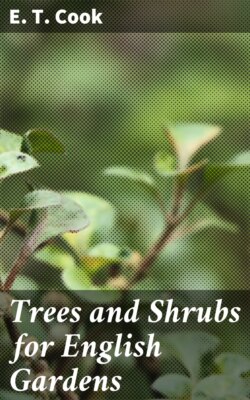Читать книгу Trees and Shrubs for English Gardens - E. T. Cook - Страница 4
На сайте Литреса книга снята с продажи.
ОглавлениеCHINESE GUELDER ROSE.
Perhaps no beautiful and now well-known shrub is more neglected than beautiful Exochorda grandiflora (the Pearl Bush). Its near relatives, the Spiræas, are in every shrubbery, but one may go through twenty and not see Exochorda. Even of the Spiræas one does not half often see enough of S. Thunbergi, a perfect milky way of little starry bloom in April and a most shapely little bush, or the double-flowered S. prunifolia, with its long wreaths of flower-like double thorn or minute white roses and its autumn bravery of scarlet foliage. The hardy Magnolias are not given the opportunity they deserve of making our gardens lovely in earliest summer. Who that has seen Magnolia stellata in its April dress of profuse white bloom and its summer and autumn dignity of handsome though not large foliage, would endure to be without it? or who would not desire to have the fragrant chalices of M. soulangeana, with their outside staining of purple, and M. conspicua, of purest white in the early months of March and April? And why does not every garden hold one, at least, of the sweet Chimonanthus, offering, as it does in February, an abundance of its little blooms of a fragrance so rich and powerful that it can be scarcely matched throughout the year?
A GROUPING OF MAGNOLIA STELLATA.
Cassinia fulvida, still known in nurseries by its older name of Diplopappus, in winter wears its fullest dress of tiny gold-backed leafage in long graceful sprays, that are borne in such profusion that they only beg to be cut to accompany the rare flowers of winter that we bring indoors to sweeten and enliven our rooms.
Of small-flowering trees none is lovelier than the Snowy Mespilus (Amelanchier), and for a tree of somewhat larger size the good garden form of the native Bird Cherry is beautiful in the early year. The North American Halesia (the Snowdrop Tree) should be in every garden, either as a bush or tree, every branch hung in May with its full array of pendent bloom of the size and general shape of Snowdrops, only of a warm and almost creamy instead of a cold snow-white colour.
Few spring-flowering shrubs are more free and graceful than Forsythia suspensa, and if it can be planted on a slight eminence and encouraged to throw down its many-feet-long graceful sprays it then exhibits its best garden use. The Chinese Viburnum plicatum is another shrub well known but unfairly neglected, flowering with the earliest Irises. Grouped with the grand Iris pallida dalmatica it is a thing never to be forgotten.
ÆSCULUS PARVIFLORA (late July).
Æsculus (Pavia) parviflora, blooming in July when flowering shrubs are rare, is easily grown and strikingly handsome, and yet how rarely seen! Calycanthus floridus, with its spice-scented blooms of low-toned crimson, also a late summer flower, is a fine thing in a cool, well-sheltered corner, where the sun cannot burn the flowers. The Rose Acacia (Robinia hispida), trained on a wall or house, is as beautiful as any Wistaria, and the quality of the low-toned rosy bloom of a much rarer colour. It is quite hardy, but so brittle that it needs close and careful wall training or other support. To name a few others in the same kind of category, but rather less hardy, the Sweet Bay is the noblest of evergreen bushes or small trees; the Tamarisk, with its grey plumes of foliage and summer flower-plumes of tenderest pink, is a delightful plant in our southern counties, doing especially well near the sea. Clethra alnifolia, against a wall or in the open, is a mass of flower in late summer, and the best of the Hibiscus syriacus, or Althæa frutex, the shrubbery representatives of Mallows and Hollyhocks, are autumn flowers of the best class. A bushy plant of half-woody character that may well be classed among shrubs, and that was beloved of our grandmothers, is Leycesteria formosa, a delightful thing in the later autumn. The large-fruited Euonymus (Spindle Tree) is another good thing too little grown.
DOUBLE-FLOWERED SLOE OR BLACKTHORN.
For a peaty garden there are many delightful plants in the neglected though easy-to-be-had list. One of these is the beautiful and highly fragrant Azalea occidentalis, all the better that the flowers and leaves come together and that it is later than the Ghent Azaleas. Then there are the two sweet-scented North American Bog Myrtles, Myrica cerifera and Comptonia asplenifolia, the charming little Leiophyllum buxifolium, of neatest bushy form, and the Ledum palustre, whose bruised leaves are of delightful aromatic fragrance; Vaccinium pennsylvanicum, pretty in leaf and flower and blazing scarlet in autumn, and Gaultheria Shallon, a most important sub-shrub, revelling in moist peat or any cool sandy soil.
These examples by no means exhaust the list of desirable shrubs that may be found for the slightest seeking. This brief recital of their names and qualities is only meant as a reminder that all these good things are close at hand, while many more are only waiting to be asked for.
